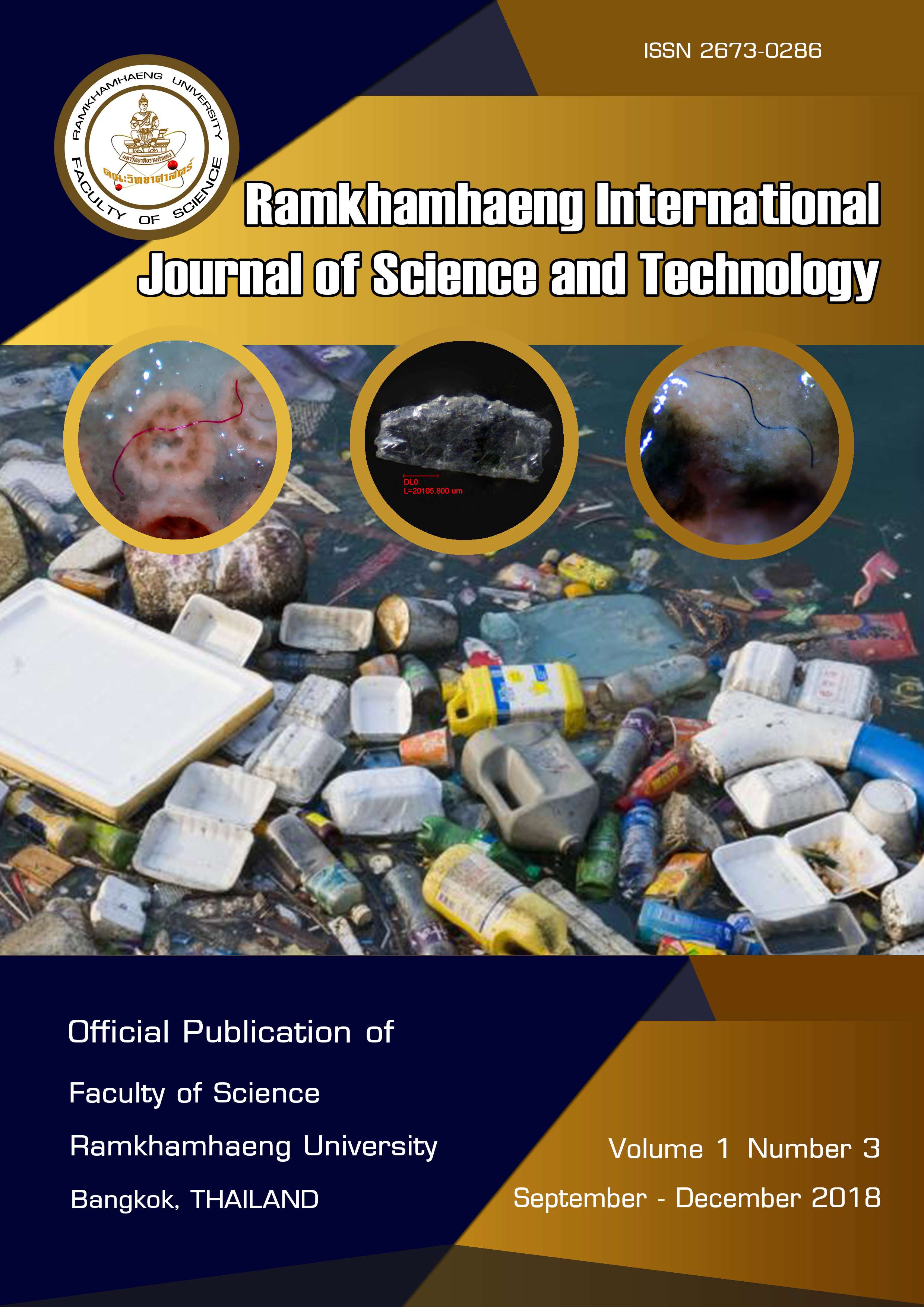Microplastics accumulation by spionid polychaetes in Thai waters
Keywords:
annelid, microplastics, pollution, polychaete, Gulf of Thailand, Andaman SeaAbstract
Marine debris and microplastics are among interesting research topics in the ASEAN community. Contamination of microplastics through the food web in various coastal and marine ecosystems is recognized as a significant problem nowadays. This study aimed to examine the abundance of microplastics in the spionid polychaetes sampled from Hat Pak Meng, Trang Province, in the Andaman Sea, and Pak Nam Lang Suan, Chumphon Province, in the Gulf of Thailand. The microplastics were extracted using hydrogen peroxide digestion method and counted using a stereoscopic microscope. The microplastics accumulation in polychaetes at Pak Nam Lang Suan (2.86±1.04 items/individual) was higher than that at Hat Pak Meng (1.91±0.41 items/individual)(p<0.05). The majority of particles varied between 501-1,000 μm in size, whereas the plastic fragments in a range of 1,501-2,000 μm had the lowest abundance. Pak Nam Lang Suan is an estuary influenced by a large river, resulting in a high quantity of microplastics compared to Hat Pak Meng. This study provides baseline data of microplastics contamination in wild annelids living in coastal habitats in Thailand.
References
Andrady AL (2017) The plastic in microplastics: A review. Mar Pollut Bull 119:12–22
Browne MA, Crump P, Niven SJ, Teuten E, Tonkin A, Galloway T, Thompson R (2011) Accumulation of microplastic on shorelines woldwide: sources and sinks. Environ Sci Technol 45:9175–9179
Browne MA, Niven SJ, Galloway TS, Rowland SJ, Thompson RC (2013) Microplastic moves pollutants and additives to worms, reducing functions linked to health and biodiversity. Current Biology 23(23): 2388–2392
Cole M, Lindeque P, Halsband C, Galloway TS (2011) Microplastics as contaminants in the marine environment: A review. Mar Pollut Bull 62:2588–2597
Cooper DA, Corcoran PL (2010) Effects of chemical and mechanical processes on the degradation of plastic beach debris on the island of Kauai, Hawaii. Mar Pollut Bull 60:650–654
Corcoran PL, Biesinger MC, Grifi M (2009) Plastics and beaches: a degrading relationship. Mar Pollut Bull 58:80–84
Donohue MJ, Timmers MA, Oceanic N (2005) Marine Debris of the Northwestern Ha- waiian Islands: Ghost Net Identification.
Eriksen M, Lebreton LCM, Carson HS, Thiel M, Moore CJ, Borerro MJ, Galgini F, Ryan PG, Reisser J (2014) Plastic pollution in the world’s oceans: More than 5 trillion plastic pieces weighing over 250,000 tons afloat at Sea. PLoS ONE 9:111913
Fauchald K (1973) Polychaetes from Central American Sandy Beaches. Bulletin of the South California Academy of Sciences 72(1):19–31
Gewert B, Plassmann MM, MacLeod M (2015) Pathways for degradation of plastic polymers floating in the marine environment. Environ Sci Process Impacts 17:1513–1521
Gong J, Kong T, Li Y, Li Q, Li Z, Zhang J (2018) Biodegradation of microplastic derived from poly (ethylene terephthalate) with bacterial whole-cell biocatalysts. Polymer 10:1326
Green, D.S., 2016. Effects of microplastics on European flat oysters, Ostrea edulis and their associated benthic communities. Environ. Pollut. 216:95–103
Hidalgo-Ruz V, Gutow L, Thompson RC, Thiel M (2012) Microplastics in the marine environment: A review of the methods used for identification and quantification. Environmental Science and Technology 46(6):3060–3075
Ivar do Sul JA, Costa MF (2014) The present and future of microplastic pollution in the marine environment. Environ Pollut 185:352–364
Jang M, Shim WJ, Han GM, Song YK, Hong SH (2018). Formation of microplastics by polychaetes (Marphysa sanguinea) inhabiting expanded polystyrene marine debris. Mar Pollut Bull 131:365-369
Law KL, Thompson RC (2014) Microplastics in the seas. Science 345:144–145
Mathalon A, Hill P (2014) Microplastic fibers in the intertidal ecosystem surrounding Halifax Harbor, Nova Scotia. Marine Pollution Bulletin 81(1):69–79.
Murray F, Cowie PR (2011) Plastic contamination in the decapod crustacean Nephrops norvegicus (Linnaeus, 1758). Marine Pollution Bulletin 62(6):1207–1217.
Naidu SA, Rao VR, Ramu K (2017) Microplastics in the benthic invertebrates from the coastal waters of Kochi, Southeastern Arabian Sea. Environ Geochem Health 40:1377–1383
Park CH, Kang YK, Im SS (2004) Biodegradability of cellulose fabrics. J Appl Polym Sci 94:248–253
Qiu Q, Peng J, Yu X, Chen F, Wang J, Dong F (2015) Occurrence ofmicroplastics in the coastal marine environment: first observation on sediment of China. Mar Pollut Bull 98:274–280
Song YK, Hong SH, Jang M, Han GM, Jung SW, Shim WJ (2017) Combined Effects of UV Exposure Duration and Mechanical Abrasion on Microplastic Fragmentation by Polymer Type. Environ Sci Technol 51:4368–4376
Thompson RC, Moore CJ, Vom Saal FS, Swan SH (2009) Plastics, the environment and human health: Current consensus and future trends. Philos Trans R Soc B: Biol Sci 364:2153–2166
Thompson RC, Olsen Y, Mitchell RP, Davis A, Rowland SJ, John AWG, McGonigle D, Russell AE (2004) Lost at sea: Where does all the plastic? Science 304:838
UNEP (2016). Marine plastic debris and microplastics–Global lessons and research to inspire action and guide policy change. United Nations Environment Programme
Van Cauwenberghe L, Vanreusel A, Mees J, Janssen CR (2013) Microplastic pollution in deep-sea sediments. Environ Pollut 182:495–499
Veiga JM, Fleet D, Kinsey S, Nilsson P, Vlachogianni T, Werner S, Galgani F, Thompson RC, Dagevos J, Gago J, Sobral P, Cronin R (2016) Identifying sources of marine litter. MSFD GES TG Marine Litter Thematic Report
Wright SL, Rowe D, Thompson RC, Galloway TS (2013a) Microplastic ingestion decreases energy reserves in marine worms. Curr Biol 23:1031-1033
Wright SL, Thompson RC, Galloway TS (2013b) The physical impacts of microplastics on marine organisms: A review. Environ Pollut 178:483–492
Zhao S, Zhu L, Wang T, Li D (2014) Suspendedmicroplastics in the surface water of the Yangtze Estuary System, China: first observations on occurrence, distribution. Mar Pollut Bull 86:562–568
Downloads
Published
Issue
Section
License
Copyright Notice: a copyright on any article in the published journal is retained by the Ramkhamhaeng International Journal of Science and Technology. Readers or Users grant the right to use of the Article contained in the Content in accordance with the Creative Commons CC BY-NC-ND license and the Data contained in the Content in accordance with the Creative Commons CC BY-NC-ND.



